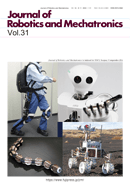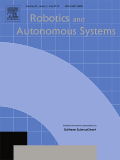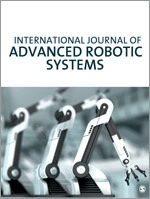
AUTONOMOUS ROBOTS
Scope & Guideline
Leading the Charge in Autonomous Robotics Research.
Introduction
Aims and Scopes
- Autonomous Navigation and Control:
Research in this area includes algorithms and systems for enabling robots to navigate and operate independently in various environments, incorporating techniques from reinforcement learning, path planning, and sensor fusion. - Human-Robot Interaction (HRI):
This focus area examines how robots can effectively work alongside humans, including understanding human intentions, learning from human interactions, and adapting behaviors in collaborative tasks. - Multi-Robot Systems and Swarm Robotics:
Studies involve the coordination and collaboration of multiple robots to achieve complex tasks, exploring decentralized control, communication strategies, and emergent behaviors. - Robotic Perception and Sensing:
This includes advancements in the perception capabilities of robots, such as visual, auditory, and haptic sensing, to enhance their understanding of the environment and improve interaction capabilities. - Machine Learning and Artificial Intelligence in Robotics:
A significant emphasis is placed on applying machine learning techniques for improving robot performance, including learning from demonstrations, reinforcement learning, and data-driven decision-making. - Robustness and Adaptability in Robotics:
Research focuses on developing methods that enable robots to adapt to changing environments and unforeseen circumstances, ensuring reliable operation in real-world scenarios.
Trending and Emerging
- Integration of Large Language Models (LLMs):
Recent studies have increasingly focused on the application of LLMs in robotics, particularly for enhancing natural language understanding, task planning, and human-robot communication. - Reinforcement Learning and Imitation Learning:
There is a growing trend towards utilizing reinforcement learning and imitation learning techniques, particularly in complex tasks such as navigation and manipulation, which allow robots to learn from real-world interactions. - Robotics in Healthcare and Assistance:
Research addressing the use of autonomous robots in healthcare settings, including robotic assistance systems and rehabilitation robots, has gained traction, driven by the demand for innovative solutions in eldercare and medical support. - Self-Supervised Learning and Adaptation:
Emerging themes include self-supervised and semi-supervised learning approaches that enable robots to improve their performance through interaction with their environment, reducing the need for extensive labeled datasets. - Robustness in Uncertain Environments:
There is an increasing emphasis on developing algorithms that allow robots to operate reliably under uncertainty, particularly in applications involving exploration, mapping, and human-robot collaboration.
Declining or Waning
- Traditional Robotics Control Methods:
There has been a noticeable decrease in publications focusing solely on classical control methods, such as PID controllers, as the field shifts towards more adaptive and learning-based approaches. - Basic Robotic Manipulation Techniques:
Research centered around fundamental manipulation techniques without integration of advanced perception or learning has waned, as there is a growing preference for studies that incorporate complex interactions and contextual awareness. - Static Environment Robotics:
The exploration of robots operating in static, controlled environments has decreased, with more emphasis now placed on dynamic environments that require real-time adaptability.
Similar Journals

Journal of Robotics and Mechatronics
Advancing the Future of Robotics and MechatronicsJournal of Robotics and Mechatronics, published by FUJI TECHNOLOGY PRESS LTD, stands at the forefront of innovation in the fields of robotics and mechatronics. Since its inception in 1989, this Open Access journal has become a vital resource for researchers, professionals, and students interested in advances that merge technology with mechanical systems, offering critical insights into practical applications and theoretical developments. With a commendable impact factor reflected in its Q2 rankings in both Computer Science (miscellaneous) and Electrical and Electronic Engineering, the journal serves as a platform for disseminating high-quality research and fostering academic collaborations. The journal enjoys wide accessibility since transitioning to Open Access in 2007, allowing for a global audience to engage with groundbreaking findings relevant to both industry and academia. Based in Tokyo, Japan, the Journal of Robotics and Mechatronics aspires to bridge the gap between research and practical implementation, encouraging the exploration of novel concepts and the sharing of scientific knowledge.

Robotic Intelligence and Automation
Shaping Tomorrow's Automation Landscape.Robotic Intelligence and Automation is a pioneering academic journal dedicated to the exploration and advancement of knowledge within the realms of robotics, artificial intelligence, and automation technologies. Published by EMERALD GROUP PUBLISHING LTD in the United Kingdom, this journal serves as a critical platform for researchers, professionals, and students who strive to understand and innovate in these rapidly evolving fields. With an impressive visibility across multiple disciplines, it has achieved a respectable Q2 ranking in Computer Science Applications, Control and Systems Engineering, Electrical and Electronic Engineering, and Industrial and Manufacturing Engineering, while also being recognized in Q3 for Artificial Intelligence and Human-Computer Interaction. The journal boasts a comprehensive Open Access model, allowing broad dissemination of research findings, which is vital for fostering collaboration and learning within the scientific community. Researchers can look forward to contributing to a publication that not only addresses current challenges but also seeks to shape the future of intelligent automation and robotics.

ROBOTICS AND AUTONOMOUS SYSTEMS
Leading the Charge in Robotics and Automated Technologies.ROBOTICS AND AUTONOMOUS SYSTEMS, published by Elsevier, is a leading journal in the fields of robotics and automation, providing a platform for the dissemination of high-quality, peer-reviewed research. With an impressive impact factor and a prestigious reputation, this journal is classified in the Q1 category for major fields including Computer Science Applications, Control and Systems Engineering, Mathematics, and Software as of 2023. The journal boasts an extensive archive dating back to 1988, reflecting the evolution of the discipline and fostering innovative research discussions that are crucial for advancements in autonomous technologies. Researchers, professionals, and students are encouraged to contribute to and benefit from the ongoing dialogue within these dynamic fields. Accessible through various academic resources, ROBOTICS AND AUTONOMOUS SYSTEMS stands as a pivotal information source for those dedicated to exploring the frontiers of intelligent systems.

Science Robotics
Catalyzing Tomorrow's Robotic Technologies TodayScience Robotics, published by the American Association for the Advancement of Science, is a leading journal that explores cutting-edge advancements in the field of robotics, emphasizing the intersection of artificial intelligence, mechanical engineering, and control optimization. With its ISSN 2470-9476, this prestigious journal holds an impressive Q1 ranking across pivotal categories for 2023, including Artificial Intelligence, Computer Science Applications, Control and Optimization, and Mechanical Engineering. It has garnered renowned recognition in the academic community, highlighted by its high Scopus rankings—placing it in the top tier with a 99th percentile rank in Mathematics for Control and Optimization and Computer Science Applications, and maintaining a 98th percentile in Artificial Intelligence. While the journal is not currently open access, it serves as a vital repository of knowledge for researchers, professionals, and students seeking to stay at the forefront of robotic innovations. Operating from its base in Washington, DC, Science Robotics aims to disseminate world-class research that catalyzes future developments in robotics and automation technologies, making it an essential resource for those engaged in the scientific study and application of these transformative fields.

Frontiers in Robotics and AI
Connecting Minds in Robotics and AI for a Smarter FutureFrontiers in Robotics and AI is a leading journal dedicated to the exploration and dissemination of groundbreaking research in the fields of robotics and artificial intelligence. Published by FRONTIERS MEDIA SA in Switzerland, it has established itself as a vital resource for academics, professionals, and students since its inception in 2014. With an impressive Open Access model, the journal ensures that high-quality research is accessible to a global audience, fostering collaboration and innovation. The journal is recognized for its distinguished impact in the academic community, achieving Q2 quartile rankings in both Artificial Intelligence and Computer Science Applications as of 2023. It currently holds a solid position in Scopus rankings, with a rank of #123 out of 350 in Artificial Intelligence and #223 out of 817 in Computer Science Applications, reflecting its robust contribution to these dynamic disciplines. The journal's scope encompasses a wide range of topics, including but not limited to autonomous systems, machine learning, and human-robot interaction, making it an essential platform for innovative ideas and advanced research.

Studies in Informatics and Control
Empowering Researchers with Insightful FindingsStudies in Informatics and Control is a distinguished academic journal published by the NATL INST R&D INFORMATICS-ICI, specializing in the interdisciplinary fields of Computer Science and Electrical and Electronic Engineering. With an ISSN of 1220-1766 and a recognized standing within its field, this journal aims to foster innovation and disseminate high-quality research findings from 2010 through 2024. It maintains a significant presence in the academic landscape, holding a Q3 ranking in both Computer Science (miscellaneous) and Electrical and Electronic Engineering categories for 2023, which underscores its commitment to advancing knowledge and technology in these areas. While the journal is not open access, it provides valuable insights and results that are essential for researchers, professionals, and students striving to develop their expertise in informatics and control systems. Based in Romania, its contributions traverse international boundaries, appealing to a global audience keen on the latest developments and trends within these rapidly evolving fields.

Artificial Life and Robotics
Bridging Theory and Practice in Robotics ResearchArtificial Life and Robotics, published by Springer, is a prominent journal in the fields of Artificial Intelligence and Biochemistry, Genetics, and Molecular Biology, with an ISSN of 1433-5298 and E-ISSN of 1614-7456. Established in 2005, the journal has continually contributed to knowledge and innovation in these rapidly evolving disciplines and is recognized for its significant impact, as indicated by its quartile rankings in the 2023 category assessments. The journal is currently positioned in Q4 for Artificial Intelligence and Q3 for General Biochemistry, Genetics and Molecular Biology, with a notable ranking of 138/221 and 262/350 in respective research areas. While it currently does not follow an open access model, it remains a valuable resource for researchers, professionals, and students seeking to advance their understanding and application of artificial life and robotic technologies. With an emphasis on interdisciplinary research, this journal aims to bridge theoretical foundations with practical applications, making it an essential platform for cutting-edge studies and discussions in the field.

Cognitive Computation and Systems
Bridging Cognitive Science and Computational Excellence.Cognitive Computation and Systems is an innovative open-access journal published by Wiley, dedicated to advancing the fields of Artificial Intelligence, Cognitive Neuroscience, and Computer Science Applications. Based in the United Kingdom, this journal has established itself as a key resource for researchers, students, and professionals alike since its inception in 2019. With a focus on the convergence of cognitive theories and computational methodologies, Cognitive Computation and Systems aims to publish high-quality research that bridges holistic cognitive processing with algorithmic design. Although the journal is currently categorized in the lower quartiles of its fields, it provides a unique platform for disseminating pioneering ideas that can drive the vital intersection of computer vision, pattern recognition, and psychology. Scholars can take advantage of its open-access model, ensuring that research findings are freely available, thus promoting wider knowledge sharing and collaboration within these rapidly evolving domains. With its ambitious scope and commitment to quality, this journal is poised to make a significant impact in its respective fields.

Information Technology and Control
Driving excellence in information technology and systems.Information Technology and Control, published by Kaunas University of Technology, is a prominent open access journal dedicated to the fields of computer science, control and systems engineering, and electrical and electronic engineering. With an ISSN of 1392-124X and a notable reputation, the journal has continuously contributed to the dissemination of innovative research since its establishment in 2008. As of 2023, it ranks in the Q3 quartile for Computer Science Applications and in the Q2 quartile for both Control and Systems Engineering and Electrical and Electronic Engineering, reflecting its growing influence in these disciplines. The journal provides a platform for the latest developments in technologies driving the industry forward and encourages an interdisciplinary approach to problem-solving. With open-access solutions implemented in 2020, it ensures that research findings are readily accessible to a global audience, supporting knowledge transfer and collaboration among researchers, professionals, and students alike. This inaugural introduction underscores the journal's commitment to fostering innovation and excellence in the rapidly evolving landscape of information technology and control.

International Journal of Advanced Robotic Systems
Discovering Tomorrow’s Robotics TodayThe International Journal of Advanced Robotic Systems is a premier academic journal, published by SAGE Publications Inc., dedicated to fostering innovation and research in the rapidly evolving field of robotics. With an ISSN of 1729-8814, this Open Access journal has been providing unrestricted access to cutting-edge research since 2004, making it an invaluable resource for researchers, professionals, and students alike. The journal aims to disseminate high-quality, peer-reviewed articles that cover a wide range of topics, including but not limited to robotic systems, automation, artificial intelligence, and sensor technologies. By promoting interdisciplinary collaboration and encouraging novel approaches, the International Journal of Advanced Robotic Systems plays a crucial role in advancing the frontiers of robotics and ensuring its impactful application across various industries. Engaging with this journal not only keeps you at the forefront of the latest developments but also contributes to the global discourse on robotics and its advancements in science and technology.